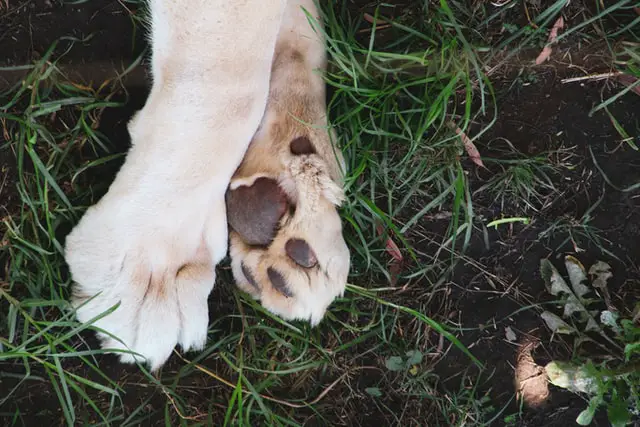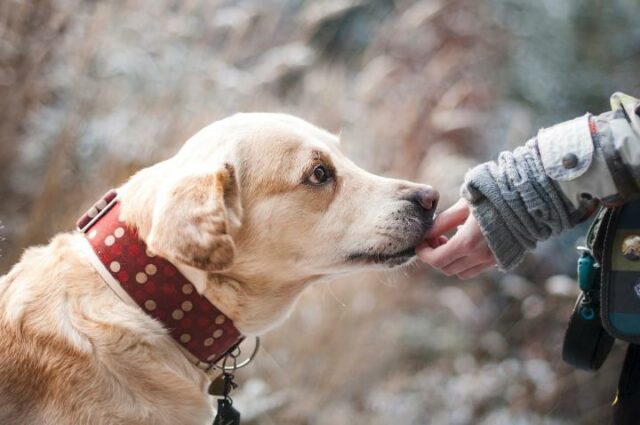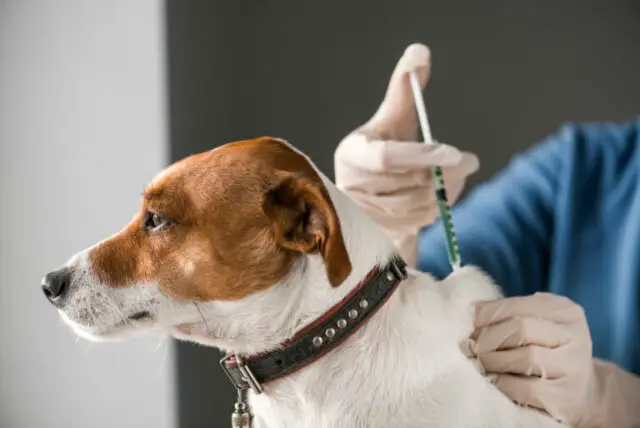Like old wives’ tales and urban legends, there are many dog myths out there that many of us have come to believe over time. These things range from the silly to the extreme. How do we know which ones are true and which ones are fake news? We asked experts and vets to weigh in and debunk the 20 worst dog myths and other interesting ‘facts’ about our favorite four-legged friends.
Worst Dog Myth #1: Garlic is a good remedy for fleas and ticks

Here’s a common myth on the internet: garlic gets rid of fleas and ticks. Unfortunately, this is not true. Garlic will not help with fleas and ticks in your pets. In fact, it will probably give your dog something called hemolytic anemia. A condition where the body attacks and destroys its red blood cells. You do not want your dog to have this because it is potentially fatal and the treatment for this disease is long and expensive.
It’s not worth the risk. Skip the garlic.
Worst Dog Myth #2: Dogs have clean mouths
Many people believe that dogs’ mouths are clean because they think their saliva can heal wounds. This is absolutely incorrect. While dog saliva helps clean their fur, their mouths are not in any way antiseptic. Plus, if you really think about it, dogs eat their poop. Those cute doggy mouths are teeming with bacteria—and yes, they are very filthy.
Worst Dog Myth #3: Dogs can catch a cold

Dogs sneeze. That’s a fact. We have all seen it. So it’s pretty safe to assume that they also catch colds, right? Wrong! Dogs can get infected with certain viruses like leptospirosis and parvo. They are also susceptible to bacterial infections like pneumonia. Hard to believe, but they do not get common colds as humans do.
Worst Dog Myth #4: Rescue dogs are bad because you don’t know where they came from
They say you should never adopt a rescue from the pound because they tend to be more problematic than their more domesticated counterparts. This is an unfair assessment. Just because puppies were raised at home does not mean they grow up to be nice dogs. Some rescues are extremely sweet and gentle. Animal rescue centers and organizations have programs and training that help these dogs to become fit pets. We should give them a chance.
Worst Dog Myth #5: Dogs have sweat glands

This one is not entirely wrong. Dogs do have sweat glands, but it’s not found where you think. They sweat through their paws. Dogs cool off by panting. The air exchange allows the moist lining of their lungs to cool them. Some dogs such as pugs and bulldogs, who have poor air exchange, are more prone to heatstroke when they get hot.
Worst Dog Myth #6: My fenced yard means I don’t need to worry about worms
People think that just because their pups do not go over their fence means they can’t get worms. While the fence definitely helps stop your pets from going through trash and playing with other undesirables, it is not a mystical barrier that can keep intestinal parasites and heartworms from getting to your pets. These parasites are carried in the poop and piss from various animals, rodents, and even birds. These can be deposited in the soil and can survive for up to several years! Heartworms can also travel through mosquitoes that even bug spray can’t prevent at all times.
Worst Dog Myth #7: I can give ibuprofen to my dog

‘Ibuprofen is safe and effective to humans so maybe it won’t hurt to give my dog’. False again. Ibuprofen is toxic to dogs and can cause kidney and liver problems. Some vets may prescribe Tylenol or aspirin for dogs, but the dose must be very specific to avoid complications. You must never give human medicine to your pets without consulting an animal specialist.
Worst Dog Myth #8: My dog is hypoallergenic
Sorry to burst your bubble, but no dog is truly hypoallergenic. Some dogs are marketed as such because they shed very little and the allergens on their fur don’t get released into the air. If you’re allergic, but still really want a dog, here are a few tips: get a breed with less hair, keep them out of the bedroom, and make sure to bathe them weekly. Check our list of breeds that are perfect for allergic fur parents.
Worst Dog Myth #9: Dogs are colorblind

No. Dogs, cats, and other animals can actually see color. The only thing is, they don’t see as much color as humans do. But don’t feel sad for them. This ‘disability’ is the same thing that helps them to see better at night. Impressive.
Worst Dog Myth #10: A dry nose means a sick dog.
This last one is a common misconception that has been passed down from generations. Experts say that a dog’s dry nose just really means that your dog has a dry nose and it is not an indication of their overall health. If you are really worried, check if your dog is dehydrated or if it’s too hot in your house. They may also develop sunburn on their noses or get allergic to their food bowls. Go visit a vet to ease your mind.
Worst Dog Myth #11: Dogs heal themselves by licking their wounds

People believe that dog saliva is antiseptic and can clean their wounds. This is not true at all. In fact, it’s counter-intuitive. Your dog’s mouth is full of bacteria and is far more likely to cause infection and delay healing in their wound when they lick it. Experts advise using saline solution, a disinfecting solution, or hydrogen peroxide instead when treating wounds.
Worst Dog Myth #12: Brushing my dog’s teeth is silly

You might feel silly doing it. After all, wolves and foxes don’t have their teeth brushed and they seem alright in the wild, right? Not! Dental disease can cause health issues in dogs and it can be painful for them to have bad teeth. Experts say brushing helps minimize dog dental problems. When you regularly brush them you are also checking their mouths for internal tumors and other problems that may have gone unnoticed.
Worst Dog Myth #13: A human year is equal to 7 in dog years

We have all heard this one many times before. Dog breeds and dog sizes have varying life spans. Experts say that small breeds tend to live longer while large breeds tend to have shorter life spans. New guidelines from Boston’s Animal Rescue League assume that a 1-year-old dog is equal to a 12-year-old human. The amount doubles after that (2 is equal to 24 years). Continue adding 4 years for every age that follows.
Worst Dog Myth #14: You can’t teach an old dog new tricks

Is it ever too late for old dogs to learn new tricks? Apparently not according to the experts. It’s best to teach dogs when they are young, but your dog can still learn new things at any stage of life. The process may be harder and could take longer, but there’s still hope. They say that socialization, obedience, behavior modification, and even potty training can still be taught to older dogs. You can try to do it yourself or have a certified trainer work with your pet.
Worst Dog Myth #15: A dog will cry out if they’re feeling pain

The answer is not all the time. It’s important to listen for changes in sounds and vocalizations your dog makes, but that is not the only indication if your dog is in pain. Check out their posture. Are they limping? That’s one of the sure ways to know. Licking a particular paw or scratching is another. Are they walking gingerly? tucking their tummy? Are they hunched over or holding their head down? These are the signs to look out for to know if your dog is hurting.
Worst Dog Myth #16: There’s a reason dogs eat grass

No one knows for sure, but experts argue this behavior goes back to the wild origins of dogs. During their meat-hunting days, they ate all the prey as well as the gut and the plant material it contained. Nowadays, they retain that instinct to take in vegetation and may eat grass partly out of some deep-seeded programming. Grass is perfectly fine as long as it isn’t coated in pesticides or herbicides
Worst Dog Myth #17: I don’t need to vaccinate my dog

You may or may not like vaccinating your dog, but rabies is a human health issue too and laws require you to vaccinate your pups. Also, some establishments and facilities require your pets to have certain vaccines. The best way is still to consult your vet so you could determine the best action for you and your pet.
Worst Dog Myth #18: My dog’s thick fur coat means they stay warm in winter

While it helps to have thicker fur to keep from cold, a thick-coated dog will still get frostbite on their paws, genital region, and ears during the winter season. Still, wintertime can be fun for dogs as long as they are not exposed to harsh climates for extended amounts of time.
Worst Dog Myth #19: Some dog breeds are more aggressive than others

It’s an age-old debate. Nature versus nurture. Some dog breeds have been bred to become guard dogs and hunters for centuries. Being aggressive is stamped in their DNA. On the flipside, any dog who endures abuse or neglect can show the same behavior. Aggression also comes out during life-threatening situations and if your dog is anxious. It’s important to know your dog and how to handle them. Seek the help of a trainer or an animal behavior expert if your circumstances call for it.
Worst Dog Myth #20: I don’t need to spay or neuter my dog

Some studies have shown that adult dogs that did not go under the procedure develop health problems over time.
Overpopulation in dogs has also become an issue. You should do it. It’s the responsible thing to do. Ask your vet for advice if you have reservations.
The post Busted: Debunking The 20 Worst Dog Myths appeared first on I Love My Dog So Much.
This content was originally published here.

